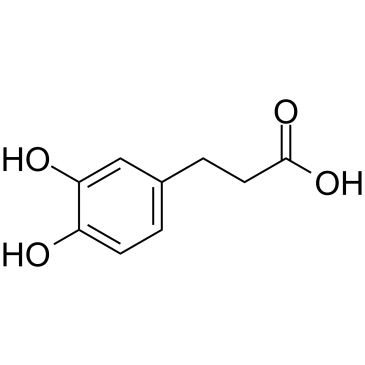3,4-Dihydroxyhydrocinnamic acid

3,4-Dihydroxyhydrocinnamic acid structure
|
Common Name | 3,4-Dihydroxyhydrocinnamic acid | ||
|---|---|---|---|---|
| CAS Number | 1078-61-1 | Molecular Weight | 182.173 | |
| Density | 1.4±0.1 g/cm3 | Boiling Point | 417.5±30.0 °C at 760 mmHg | |
| Molecular Formula | C9H10O4 | Melting Point | 136-139 °C(lit.) | |
| MSDS | Chinese USA | Flash Point | 220.4±21.1 °C | |
| Symbol |

GHS07 |
Signal Word | Warning | |
|
A metabolite profiling approach to identify biomarkers of flavonoid intake in humans.
J. Nucl. Med. 139 , 2309-14, (2009) Flavonoids are phytochemicals that are widespread in the human diet. Despite limitations in their bioavailability, experimental and epidemiological data suggest health benefits of flavonoid consumption. Valid biomarkers of flavonoid intake may be useful for e... |
|
|
Poly(N-vinylimidazole/ethylene glycol dimethacrylate) for the purification and isolation of phenolic acids.
Anal. Chim. Acta 885 , 199-206, (2015) In this study we report the novel polymeric resin poly(N-vinyl imidazole/ethylene glycol dimethacrylate) for the purification and isolation of phenolic acids. The monomer to crosslinker ratio and the porogen composition were optimized for isolating phenolic a... |
|
|
Molecular modifications on carboxylic acid derivatives as potent histone deacetylase inhibitors: Activity and docking studies.
Bioorg. Med. Chem. 17 , 5219-28, (2009) In the light of known HDAC inhibitors, 33 carboxylic acid derivatives were tested to understand the structural requirements for HDAC inhibition activity. Several modifications were applied to develop the structure-activity relationships of carboxylic acid HDA... |
|
|
Genipin-crosslinked catechol-chitosan mucoadhesive hydrogels for buccal drug delivery.
Biomaterials 37 , 395-404, (2015) Drug administration via buccal mucosa is an attractive drug delivery strategy due to good patient compliance, prolonged localized drug effect, and avoidance of gastrointestinal drug metabolism and first-pass elimination. Buccal drug delivery systems need to m... |
|
|
Adhesive barrier/directional controlled release for cartilage repair by endogenous progenitor cell recruitment.
Biomaterials 39 , 173-81, (2015) A new design concept in controlled release chemistry is reported in this study. Unlike current depots that release drugs in all direction by an isotropic way, we demonstrate that directional release only to a clinically beneficial direction results in improve... |
|
|
Rapid Gelling Chitosan/Polylysine Hydrogel with Enhanced Bulk Cohesive and Interfacial Adhesive Force: Mimicking Features of Epineurial Matrix for Peripheral Nerve Anastomosis.
Biomacromolecules 17 , 622-30, (2016) Prompt and strong reconnection of severed peripheral nerves is crucial to nerve regeneration. The development of biocompatible nerve adhesives that are stronger than commonly used fibrin glue would be extremely beneficial to this field. We designed an in situ... |
|
|
Contribution of cinnamic acid analogues in rosmarinic acid to inhibition of snake venom induced hemorrhage.
Bioorg. Med. Chem. 19 , 2392-6, (2011) In our previous paper, we reported that rosmarinic acid (1) of Argusia argentea could neutralize snake venom induced hemorrhagic action. Rosmarinic acid (1) consists of two phenylpropanoids: caffeic acid (2) and 3-(3,4-dihydroxyphenyl)lactic acid (3). In this... |
|
|
Chlorogenic acid, quercetin-3-rutinoside and black tea phenols are extensively metabolized in humans.
J. Nutr. 133(6) , 1806-14, (2003) Dietary phenols are antioxidants, and their consumption might contribute to the prevention of cardiovascular disease. Coffee and tea are major dietary sources of phenols. Dietary phenols are metabolized extensively in the body. Lack of quantitative data on th... |
|
|
Identification of Echinacoside Metabolites Produced by Human Intestinal Bacteria Using Ultraperformance Liquid Chromatography-Quadrupole Time-of-Flight Mass Spectrometry.
J. Agric. Food Chem. 63 , 6764-71, (2015) Echinacoside (ECH) is one of the representative phenylethanoid glycosides. It is widely present in plants and exhibits various bioactivities. However, the extremely low oral bioavailability of ECH in rats implies that ECH may go through multiple hydrolysis st... |
|
|
Effects of phytochemicals on in vitro anti-inflammatory activity of Bifidobacterium adolescentis.
Biosci. Biotechnol. Biochem. 79 , 799-807, (2015) Probiotics have been shown to improve the condition of not only the human gastrointestinal tract but also the entire body. We found that quercetin enhances the anti-inflammatory activity of Bifidobacterium adolescentis, which is abundant in human intestines. ... |